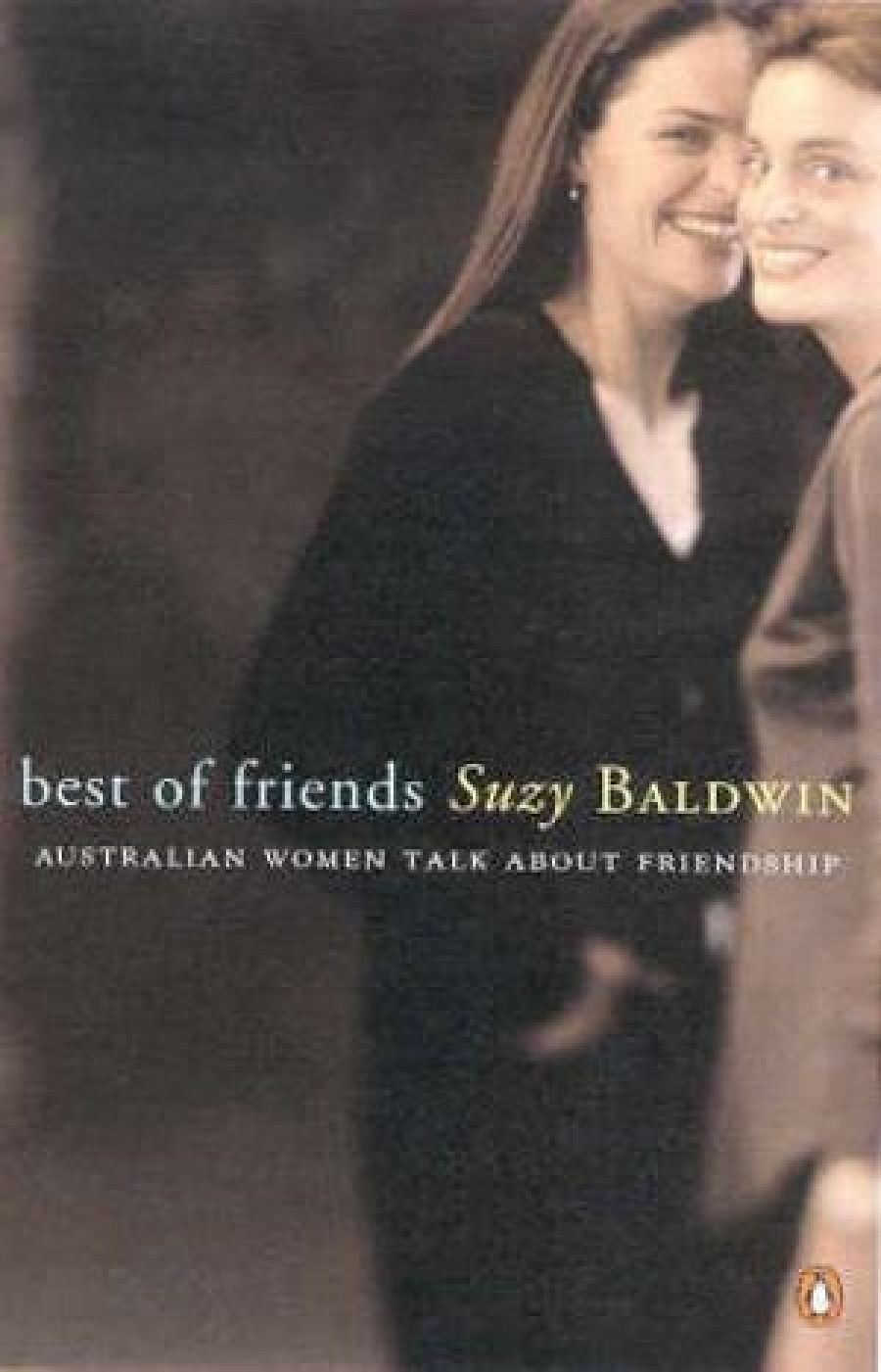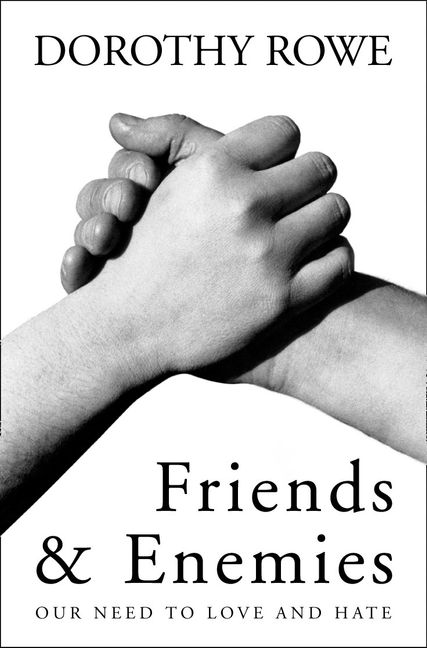
- Free Article: No
- Contents Category: Society
- Review Article: Yes
- Online Only: No
- Custom Highlight Text:
A collection of interviews with women about friendship? Well, we are all experts on the topic, and all have stories to tell. The women interviewed by Suzy Baldwin for this collection all speak fluently on the topic of friendships present and past: with women, sexual and not; with men, gay and straight; and with their partners, mothers, sisters, brothers, and children. Baldwin’s elegant introductory essay begins and ends autobiographically, but also ranges historically and philosophically amongst a number of writers about friendship, male and female, asking what is specific to women’s friendships.
- Book 1 Title: Best of Friends
- Book 1 Subtitle: Australian women talk about friendship
- Book 1 Biblio: Penguin, $19.95 pb, 265 pp
- Book 2 Title: Friends and Enemies
- Book 2 Subtitle: Our need to love and hate
- Book 2 Biblio: HarperCollins, $53.30 hb, 551 pp
- Book 2 Cover Small (400 x 600):

- Book 2 Cover (800 x 1200):

- Book 2 Cover Path (no longer required): images/1_SocialMedia/2021/August_2021/y648.jpg
Her subjects represent a remarkably homogeneous group of women, ranging roughly, it seems, from the youngest, Joanna Murray-Smith, to the oldest, Mirka Mora. Nearly all are professionals or artists, moving in professional or artistic spheres. They all represent the articulate, ‘talking classes’ of women. Many of them seem to know each other, too: in addition to the several pairs of friends (Lynne and Dale Spender; Quentin Bryce, and Wendy McCarthy), they also refer to one another. Presumably, most of them also know Suzy Baldwin quite well.
These women were chosen, she tells us, because they ‘seemed to me to have or have had especially passionate, intense, sustained and sustaining intimate friendships’. A personal connection seems inevitable, though Baldwin tries to confine much of this to the brief introduction to each interview: ‘The first time I met Elizabeth [Elliott] I put my head on her table between the bouillabaisse and the orange cake and wept with laughter.’ In contrast, the editorial voice in the interviews themselves is quite minimalist. Even though most of these women speak candidly, even painfully, about friends and lovers and children, the dominant effect is that of a series of monologues, rather than conversations. It is an odd effect in a book about human relations.
This rhetorical effect does little to break up the book’s homogeneity of class, age, and race. This is not to suggest that these women don’t all have interesting stories to tell, but even so, it’s hard not to be struck by those women whose narratives fall outside the more typical patterns of friendships being made and broken around the middle-class narratives of partners, children, relationships, and career moves interstate or overseas: for example, Mary Vallentine telling Stuart Challender that he was too ill to keep conducting the Sydney Symphony Orchestra; Barbara Blackman, trying to explain to Suzy Baldwin the difference between an intimate friendship and a ‘mate’ (‘she’s a thumper, we bring out the aggressive in each other’); and Mirka Mora, who seems not to have close friends now because her childhood friends were killed in the Holocaust. Baldwin comments in her introduction that ‘those with the most painful stories did not want to be identified publicly with them’, and this is perhaps another reason for the somewhat flat overall impression that results from reading these interviews end to end.
Some of the interviewees raise more philosophical questions about the people who are absent from this book, or about the historical and political factors affecting women’s friendships. Joanna Murray-Smith, for example, wonders whether the economic protection surrounding the middle class results in ‘less intense, less dependable, less complex notions’ of friendship ‘because friends are so rarely asked to put themselves out for you’. Anne Summers confirms this: ‘I’ve had friends offer me money, but I would prefer to try and get it from the bank.’ Dale Spender comments that the nuclear family has thrown women’s choice of friends into sharper relief, as friendship replaces the support networks of women in extended families living under the same roof.
These are the kinds of broader questions tackled by Dorothy Rowe in Friends and Enemies, a chatty, compendious account of the human necessity to form both friendships and enmities. Rowe is conscious of cultural diversity in a way that puts Baldwin’s collection into a very local perspective indeed. Rowe’s work ranges internationally, with a special focus on survivors from political traumas in Nazi Germany, in Northern Ireland, South Africa, the Middle East, the Balkans, and Australia.
Rowe writes as a psychologist, drawing on clinical experience with individuals and with groups, but her work also embraces anthropology and cognitive development, as she develops a number of key terms around which to organise her thesis. In particular, she describes the notion of ‘primitive pride’, the instinctive formation of compensatory defence mechanisms that will best keep intact ‘the meaning structure’ for the individual subject. From such pride, Rowe argues, we objectify and dehumanise our enemies, and ‘choose’ the kinds of leaders we want: mostly, we choose a powerful ‘parent-leader’ who will take responsibility for us.
Friends and Enemies moves with ease from individual case histories, including Rowe’s traumatic and still unresolved relationship with her own mother, to racial and ethnic enmity, including the enmity so many around the world feel towards Americans. For example, in discussing the way other people can hurt us by withholding confirmation of our existence, Rowe cites Graziella Dalleo, one of Argentina’s ‘disappeared’ who in 1998 was driven by the camp commandant through the streets of Buenos Aires celebrating Argentina’s victory in the World Cup. ‘I began to cry, because I remember thinking if I start shouting “I’ve disappeared”, no-one’s going to give a damn. This was the most concrete proof I ever had that I had ceased to exist.’ This story is followed by that of a woman mourning her dog, her best friend, who always ‘accepted me for what I am’.
This narrative strategy of juxtaposition generates a lively and varied pace throughout the volume: its case histories and anecdotes are always engaging, presenting very direct and personal discussion of the most painful stories. And there is some interesting consideration of method: the tribal divisions between psychologists and psychoanalysts; the problematics of moving from individual to ethnic psychology; and the cultural myopia of ‘the Western myth that good communication solves all problems’. Not all of these questions are or can be fully resolved in such a wide-ranging book, which is clearly directed more to a popular than a specialist readership. Even so, in its very diversity, Friends and Enemies reminds us that friendship – and enmity – are made in contexts that are always social and cultural, not just personal.


Comments powered by CComment